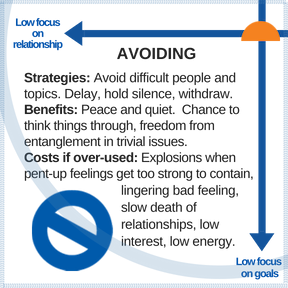 Try Using Avoiding More
Try Using Avoiding More 

You scored lower in this style in Calm settings than in other styles. This suggests that, in early stages of conflict when things are not yet emotional, you use Avoiding less than other styles. This spares you some of the weaknesses of Avoiding. For example, if people habitually avoid difficult discussion in a long-term partnership, bad feelings fester and grow. Energy and enthusiasm fades and the relationship may be endangered.
But Avoiding has important uses you may be missing out on. You'll be most effective in conflict if you are good at all five styles. So increased use of the arts of stepping back and avoiding conflict might benefit you, especially if there is a gap of 3 points or more between your lowish Avoiding score and your highest score in Calm.
When to Avoid. In Avoiding, you respond to differences by withdrawing from interaction. Neither person gets what they want; you just avoid the topic or the person. Although it has limits, Avoiding is wise, and indeed necessary, at times.
Conflict takes time and energy, and it's stressful. If we take on every battle, we run out of time and energy for the things most important to us. Avoiding is useful when:
- The topic is too trivial to merit an argument.
- You have no time or energy to talk things through.
- The conflict is with someone you have no long-term relationship with on an issue of minor importance. Why waste the energy?
- Key people are stressed or anxious. High stress reduces ability to think well and self-regulate emotions. Sometimes it's wise to delay till people are able to use their best inner resources.
- When you're not powerful or strong enough to actively resist the demands of a more powerful party, yet need a passive form of resistance.
- When it might be dangerous physically or emotionally to get in an argument.
- When timing or sequence is wrong for discussion. Eg: Maybe you need to review the budget before debating a controversial purchase.
- When you need time to think things through, gather more information, consult with others, etc., in preparation for discussion.
Ways to Strengthen Avoiding. Since Avoiding seems not to come naturally for you, you might try experimenting with avoidance responses. For example:
- Look before you leap into intense exchanges with people. Consider: 1) Whether you have the time and energy required to talk things through; 2) Whether the issue is worth the time and energy required.
- Dial back responsiveness. It's not necessary to accept every invitation to an argument. Experiment with simply sitting in thoughtful silence as others express views you disagree with. If silence is difficult for you, start by holding silence on something small, just for the practice of it.
- Delay or schedule conflict. For example, "Interesting idea, but could we talk about that some other time?" Or "Could I give you my views on that when we've got the time to really thresh it out?" Agree that certain topics are off-limit in certain times or places. Agree to discuss certain conflict-fraught topics, such as finances in a domestic partnership, on a regular basis, such as every second Saturday morning, but not at any other time.
- Learn verbal responses for Avoiding. Memorize some diplomatic crutch phrases for Avoiding: "You know, I see it a bit differently, but I respect where you are coming from...." Or "I agree we need to discuss this, but could we set this topic aside until tomorrow morning so we can focus on other things right now?" Or "You see things one way and I see them a different way. Let's just leave it at that for now."
As you ratchet up your use of Avoiding, you'll have less drama in your life, and have more time and energy for things you care about.



 Need assistance? Email center@riverhouseepress.com with a copy of the login instructions you received and a brief description of what is happening. We'll reply in one business day-usually less.
Need assistance? Email center@riverhouseepress.com with a copy of the login instructions you received and a brief description of what is happening. We'll reply in one business day-usually less. 